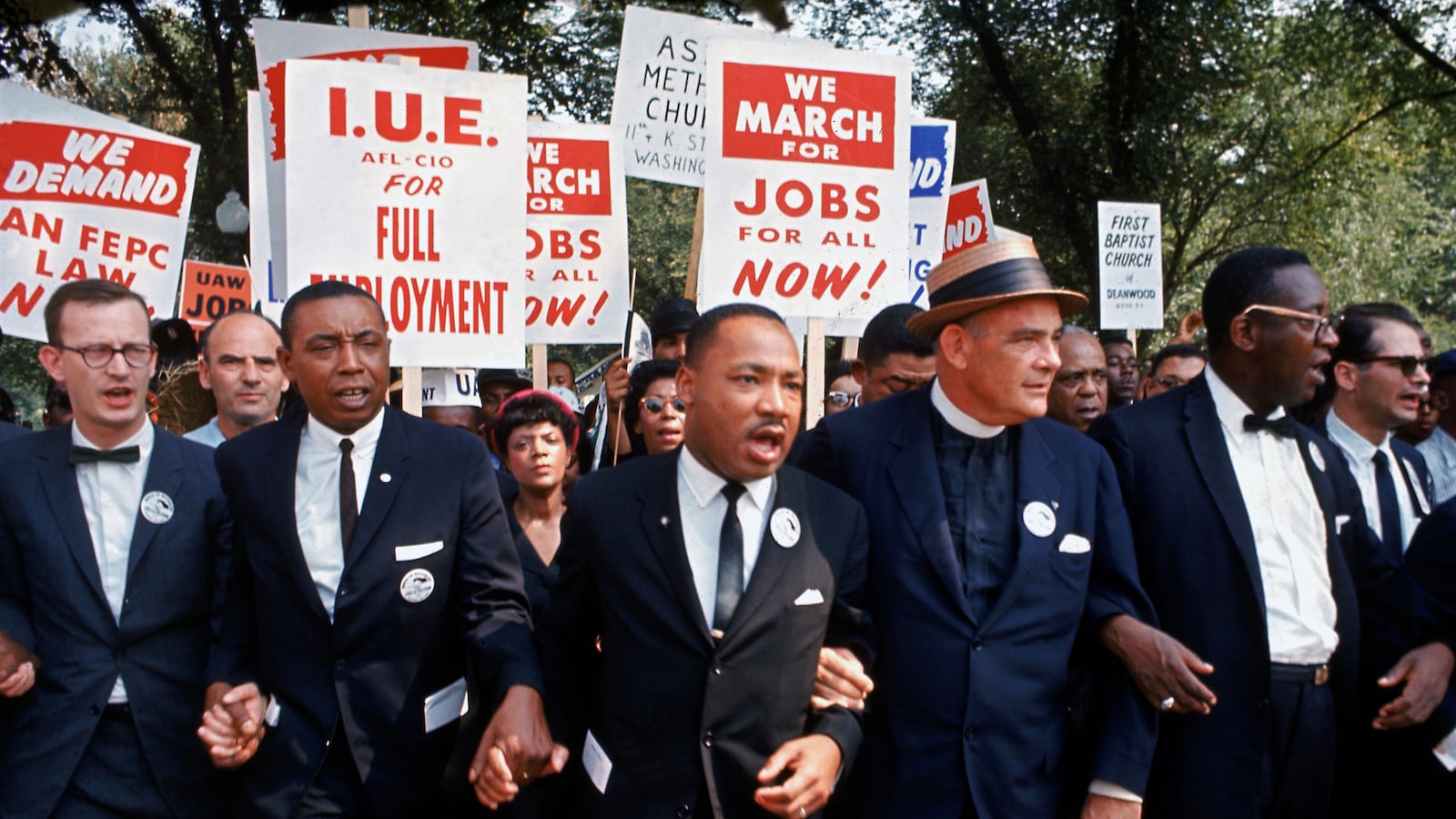In his eulogy for Rosa Parks, Jesse Jackson gave a history lesson to the American people—and to then President George W. Bush. He explained that when politicians promise to “export democracy” around the world, they aren’t referring to the chattel slavery and gender apartheid of “Jeffersonian Democracy.” According to Jackson, “They’re talking Parks-King democracy.”
From slavery and Jim Crow to an Obama-era criminal justice system more criminal than just, the black freedom movement has always exposed and opposed the worst and most wicked tendencies of the American democratic experiment. It has also illuminated its best hope for true freedom, real equality, and vital democracy.
In Ferguson, Missouri, the bullet-ridden body of Michael Brown lies on a slab somewhere, and his parents await justice, and mourn. Their tears join those of countless other black parents whose children died, for reasons trivial and frivolous, because policemen pulled the trigger.
It is imperative that we do not allow Brown’s death—and the outrage it provokes—to be reduced to mere police procedure or political theater. It is spiritual warfare. The soul of the nation is at stake as long as America maintains vicious rule over separate and unequal legal systems. The Ferguson nightmare is the culmination of a systemic pattern of abuse, and it demands, culturally and politically, a Brown-versus-Board style reformation.
The inspirational saga of history and ancestry is necessary to prevent America from indulging the illusion that Brown’s death is an isolated incident. And any education on American racial and legal crimes should begin with Douglas A. Blackmon’s Pulitzer Prize winning Slavery By Another Name: The Re-Enslavement of Black Americans from the Civil War to World War II. Abraham Lincoln signed the Emancipation Proclamation in 1863, but Blackmon, through assiduous research and astute analysis, makes clear that America didn’t free the slaves. Instead, many states passed laws widely known as the “black codes.” The “black codes” essentially outlawed black life. The lightest charge of loitering or vagrancy would carry with it the penalty of forced labor in a convict lease system of states, municipalities, white farmers, and corporations. Not only did the “black codes” reinstitute a system of unpaid labor, they created a criminal justice practice of penalizing black Americans for “crimes” white Americans can freely flaunt as part of their behavior.
The belief that a black man—any black man—is a frightening monster stalking the streets, waiting to strike the virginal and virtuous white pedestrian manifests itself in fatalities in Ferguson, and small towns and major cities across America. It also provides the cultural foundation for the legal criminality of the “War on Drugs.”
Michelle Alexander, in her bestselling book The New Jim Crow: Mass Incarceration in the Age of Colorblindness, indicts the criminalization of drugs, and convicts the criminal justice system of maintaining a war against the black poor in the name of ending drug dependency. Blacks are more likely than whites to face arrest, trial, and imprisonment for nonviolent drug offenses, even though they do not use drugs at higher rates. The consequences of a drug conviction amount to the annihilation of citizenship.
“Once you’re labeled a felon,” Alexander writes, “The old forms of discrimination—employment discrimination, housing discrimination, denial of the right to vote, denial of educational opportunity, denial of food stamps and other public benefits, and exclusion from jury service—are suddenly legal. As a criminal, you have scarcely more rights, and arguably less respect, than a black man living in Alabama at the height of Jim Crow. We have not ended racial caste in America; we have merely redesigned it.”
“Look at what Jim Crow’s done and gone / He went and changed his name,” John Mellencamp sang in 2007. Part of the alias and the disguise is masking racism with the mechanisms of large, diverse institutions. Alexander shows how mass incarceration accomplishes the task, and in his groundbreaking Racism Without Racists, Eduardo Bonilla-Silva widens the frame to present an ugly portrait of America.
Dinosaurs like Donald Sterling draw the ire of Americans, regardless of political affiliation or ideological tilt. There is hardly a more damaging and destructive label to affix on someone than “racist.” The bromide of conventional wisdom goes, if American corporations, media outlets, and politicians have no tolerance for racists, surely America does not accept racism. The flipside of America’s narrative of self-congratulation is the fixation on blacks in high places. Obama and Oprah obliterate any need to examine the educational and economic stratification of American life between blacks and whites. Silva looks at the intellectual onanism and asks some knife-edged questions, such as, “How is it possible to have this tremendous degree of racial inequality in a country where most whites claim that race is no longer relevant? How do whites explain the apparent contradiction between their professed color-blindness and the United States’ color coded inequality?”
Silva concludes that America is afflicted by the socio-optic condition of “colorblind racism.” “Instead of relying on name calling,” Silva concludes, “color blind racism otherizes softly; Instead of suggesting that minorities are genetically inferior, it suggests they are behind because they don’t work hard.”
Stacey Patton almost invents a new genre in her book of memoir and history, That Mean Old Yesterday. A victim of child abuse turned advocate for the abused, Patton presents an air-tight case that corporal punishment in black families goes directly back to the physical abuse slave owners used to discipline, punish, and control slaves. She also details the societal violation of childhood robbery. Black children, Patton argues, are rarely granted the public privileges of childhood. The way black teenagers, including Michael Brown, are subject to scrutiny of their humanity, for typical adolescent behavior like smoking marijuana or shoplifting, gives hideous visual aid to Patton’s tour of history.
That Mean Old Yesterday ends with inspiration, as Patton details how she overcame the abuse from her adoptive parents, to earn a Ph.D. in history, launch a career as a journalist, and become a leader in the movement for civil rights in America, and transparency in the foster care system. Patton is a triumphant representative of resistance in black America.
The resistance begins with rage. No culture can subject people to life underneath a dirty floorboard while its leaders walk overhead without expecting the blowback of righteous rage. James Baldwin, one of America’s greatest essayists, said that the “only time non-violence is admired is when Negroes practice it.”
In his essay collection No Name in the Street, Baldwin gives a brilliant account of the life of Malcolm X, and an appraisal of his contribution to the black struggle in American history. He writes that what made Malcolm X “unfamiliar and dangerous was not his hatred for white people, but his love for blacks, his apprehension of the horror of the black condition, and the reasons for it, and his determination so to work on their hearts and minds that they would be enabled to see their condition and change it themselves.”
Baldwin becomes a social and spiritual alchemist by blending rage with love. It is love for the self and community that often fuels black rage. The demonstrations and riots in Ferguson, to a certain extent, are the consummation of the marriage between rage and love.
American history, given the brutality and beauty of racial integration, has always made it difficult to demarcate the distance between social disorder and self-defense. In The Autobiography of Malcolm X, Malcolm X gives a statement of such simplicity and logic, it can only become radical in a culture of madness: “I believe it’s a crime for anyone who is being brutalized to continue to accept that brutality without doing something to defend himself.”
The changes made during the march from Jim Crow to Barack Obama are undeniable, and the transformation of much of American life on the racial divide amounts to a triumph of conscience. America’s celebration of itself receives constant interruption by incidents like the Michael Brown killing. All of those incidents collect to form data, and to demonstrate the relevance of the simple, but profound truth of Cornel West’s 1993 polemic, Race Matters.
To call the United States “post-racial” is to court a Christopher Columbus moment of discovering America. West’s analysis gives a philosophical overview of the role race continues to play in the daily drama of American culture. He condemns the “nihilism” in much of the black community, but not without connecting it to the hegemony of the market over American life, where “everything and anything is now up for sale.” “The basic aim of a democratic regime is to curb the use of arbitrary powers against its citizens,” West writes.
Race Matters is essential for understanding the racial dynamic in American life, just as it is crucial for navigating the intersection of primal rage, intellectual resistance, and an all encompassing, overarching love ethic. West often writes that “justice is what love looks like in public.”
The greatest contribution of the Black Freedom Movement in its literature—Toni Morrison, Ralph Ellison, Albert Murray—and its soundtrack—Curtis Mayfield, Stevie Wonder, Marvin Gaye—is an expression of how love is elemental to democracy.
Jesse Jackson tells Marshal Frady in Frady’s excellent biography of the civil rights leader and former presidential candidate that the higher mission of the civil rights movement, and of his own presidential campaigns, was “to transcend society, in a way that is more spiritual and less concrete than usual politics. You don’t strive for love between institutions; you strive for love between individuals and justice between institutions.”
Michael Brown, and those he now represents, are casualties of a culture suffering from a deficit of love. Only when the deficit turns into a surplus can justice emerge from the property of dreams, and enter the lucid world of possibility.
David Masciotra is a columnist with the Indianapolis Star. He is also the author of Mellencamp: American Troubadour (forthcoming, University Press of Kentucky).






